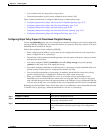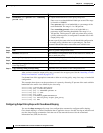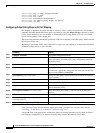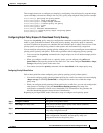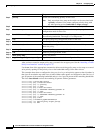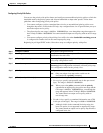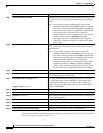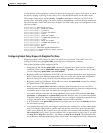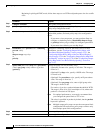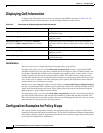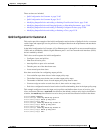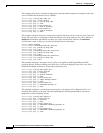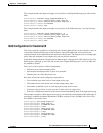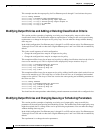
33-61
Cisco ME 3400 Ethernet Access Switch Software Configuration Guide
OL-9639-06
Chapter 33 Configuring QoS
Configuring QoS
Use the no form of the appropriate command to delete an existing policy map or class map or to cancel
the priority queuing or policing for the priority class or the bandwidth setting for the other classes.
This example shows how to use the priority with police commands to configure out-class1 as the
priority queue, with traffic going to the queue limited to 20000000 bps so that the priority queue never
uses more than that. Traffic above that rate is dropped. The other traffic queues are configured as in the
previous example.
Switch(config)# policy-map policy1
Switch(config-pmap)# class out-class1
Switch(config-pmap-c)# priority
Switch(config-pmap-c)# police 200000000
Switch(config-pmap-c)# exit
Switch(config-pmap)# class out-class2
Switch(config-pmap-c)# bandwidth percent 50
Switch(config-pmap-c)# exit
Switch(config-pmap)# class out-class3
Switch(config-pmap-c)# bandwidth percent 20
Switch(config-pmap-c)# exit
Switch(config-pmap)# exit
Switch(config)# interface gigabitethernet0/1
Switch(config-if)# service-policy output policy1
Switch(config-if)# exit
Configuring Output Policy Maps with Weighted Tail Drop
Weighted tail drop (WTD) adjusts the queue size (buffer size) associated with a traffic class. You
configure WTD by using the queue-limit policy-map class configuration command.
Follow these guidelines when configuring WTD:
• Configuring WTD with the queue-limit command is supported only when you first configure a
scheduling action, such as bandwidth, shape average, or priority. The exception to this is when
you are configuring queue-limit in the class-default.
• Beginning with Cisco IOS Release 12.2(35)SE, you can configure and attach as many output policy
maps as there are ports. Multiple output policy maps can use the same queue-limit configuration.
However, these policy maps can have only three unique queue-limit configurations.
• Beginning with Cisco IOS Release 12.2(44)SE, you can use the queue-limit command to configure
the queue-limit for CPU-generated traffic.
• When you use the queue-limit command to configure queue thresholds for a class, the WTD
thresholds must be less than or equal to the queue maximum threshold. A queue size configured with
no qualifier must be larger than any queue sizes configured with qualifiers.
• You cannot configure more than two unique threshold values for the WTD qualifiers (cos, dscp,
precedence, or qos-group) in the queue-limit command. However, there is no limit to the number
of qualifiers that you can map to those thresholds. You can configure a third unique threshold value
to set the maximum queue, using the queue-limit command with no qualifiers.
• A WTD qualifier in the queue-limit command must be the same as at least one match qualifier in
the associated class map.
• In an output policy map, when you configure a queue-limit for a unique class, all other output policy
maps must use the same format of qualifier type and qualifier value. Only queue-limit threshold
values can be different. For example, when you configure class A queue-limit thresholds for dscp
30 and dscp 50 in policy-map1, and you configure class A queue-limits in policy-map 2, you must
use dscp 30 and dscp 50 as qualifiers. You cannot use dscp 20 and dscp 40. The threshold values
can be different, but different threshold values would create a new unique queue-limit configuration.



